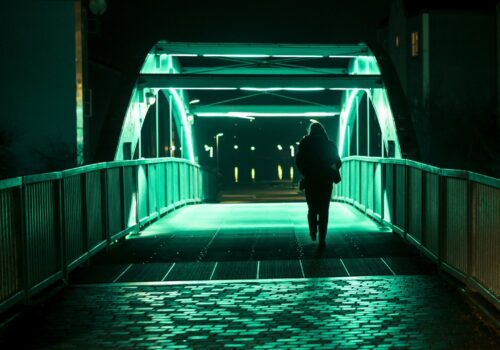
Download PDF: Pham and Barush, Swords to Shoes
Abstract
On June 2015, six years before the 500th anniversary of Ignatius’ pilgrimage, the instructors, Prof. Hung Pham, S.J. and Prof. Kathryn Barush, with a group of twelve graduate students, set off from Berkeley, California following the road where Ignatius once walked, anticipating a transformative journey of their own. Collaborating with Fr. Josep Lluís Iriberri, SJ, director of Oficina del Peregrino del Camino Ignaciano, the Camino Ignaciano Course was designed to give the students an opportunity to deepen their personal relationship with God and to serve as part of the discernment of their life direction. As Ignatius’ conversion was inspired by the lives of Saint Dominic and Saint Francis, students were moved by Saint Ignatius’ experience and his spiritual exercises. Envisioning the students as pilgrims and the classroom as the road, the course emphasized the importance of encountering sacred space and objects in situ and doing theology on the road. This piece is a visual travelogue describing our journey and some of the graces we received with a focus on four sacred sites: Loyola, Arantzazu, Montserrat, and Manresa.
A Travelogue
Towards the end of February 1522, Ignatius of Loyola, a courtier descended from Basque minor nobles, left the Loyola castle and embarked on a pilgrimage to Jerusalem. After having recovered from what had seemed to be a devastating, dream-shattering experience (he was immobilized after a cannonball struck his legs), Ignatius committed his life to the pursuit of holiness through imitating the lives of the saints and walking in the footsteps of Christ in perpetual penance. From Loyola, Ignatius made his pilgrimage through Aránzazu, Montserrat, and Manresa before entering Jerusalem on September 4, 1323 after spending nearly one-and-a-half years on the road.
Engaging in the pilgrimage, Ignatius slowly learned not to run ahead but to allow himself to be led by the Spirit. Step by step, a camino, a road was opened leading to ever deeper conversion and transformation. As the pilgrim (for this is how Ignatius refers to himself throughout his autobiography) journeyed through various locations on the physical level, he experienced conversion in the inward journey of his soul. Ignatius reminisced, “On this journey something happened to [me] which it will be good to have written, so that people can understand how Our Lord used to deal with this soul: a soul that was still blind, though with great desires to serve him as far as its knowledge went.”[1][2] It was this recognition of how God works in one’s life which inspired the Camino Ignaciano Course at the Jesuit School of Theology of Santa Clara University in Berkeley (hereafter JST). [3]

Photo: Oscar Momanyi, used with permission
In June 2015, six years before the 500th anniversary of Ignatius’ pilgrimage, the instructors, Prof. Hung Pham, S.J. and Prof. Kathryn Barush, with a group of twelve graduate students pursuing various theology degrees —six Jesuit scholastics, one religious sister, three women, and two laymen —set off from Berkeley, California following the road where Ignatius once walked, anticipating a transformative journey of their own.
Collaborating with Fr. Josep Lluís Iriberri, SJ, director of Oficina del Peregrino del Camino Ignaciano, the Camino Ignaciano Course at JST was designed to give the students an opportunity to deepen their personal relationship with God and to serve as part of the discernment of their life direction. As Ignatius’ conversion was inspired by the lives of Saint Dominic and Saint Francis, students were moved by Saint Ignatius’ experience and his spiritual exercises. Envisioning the students as pilgrims and the classroom as the road, the course emphasized the importance of encountering sacred space and objects in situ and doing theology on the road.
All knowledge begins with experience. Theological ideas and concepts emerge from experience of personal encounter with the transcendent. Faith formation and pastoral education often take place in classrooms and pulpits, far removed from concrete realities and the messiness of the daily human experience of personal encounter. When disassociated from encounter with lived reality, theological doctrines and discourse run the risk of lacking depth of meaning. Technology, used to good advantage, means that students can explore all the events and locations of the world, but on an important level technology distances them from personal engagement with the potential associative value of such events or locations. It is one thing to watch a live event. It is another to actually be part of it, to live it. It is one thing to read theology. It is another to wrestle with and to do theology. It is one thing to theologize about Ignatius’ trust in God. It is another to walk in the 105 degree Fahrenheit summer heat for 10 to 15 miles in order to personally experience what such a trust entails. Bodily experience and even muscle memory become important parts of spiritual growth and theological discourse. It is on the road where both students and teachers participate and engage as pilgrims. It is on the road where the depth of thought and imagination is enacted. It was on the road where the Risen Lord appeared in the form of a stranger, whom pilgrims met, encountered, and were transformed (Luke 24: 13-35). It is important to note that it was not the saint whom we were chasing after, but a personal encounter with the Divine on the road where the young Ignatius once walked his conversion.
CAMINO IGNACIANO
Jesuit School of Theology of Santa Clara at Berkeley
Summer 2015






